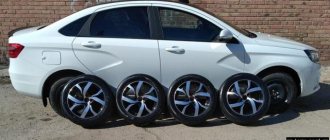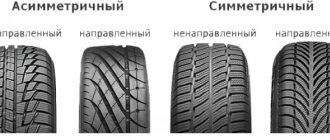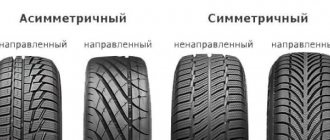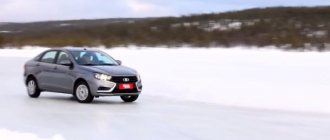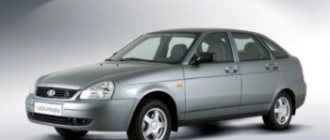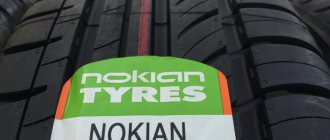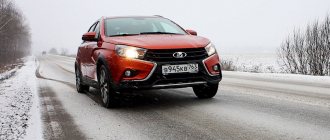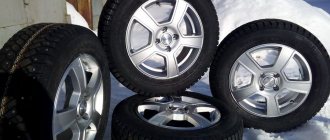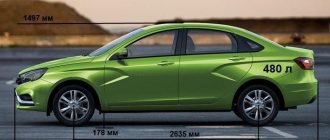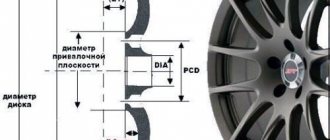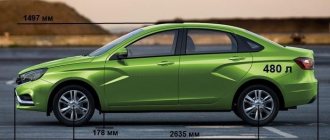The start of sales of the Lada Vesta SV Cross all-terrain station wagon was given about a year ago. The new product of the domestic automobile industry turned out to be quite successful in sales. This is facilitated by a fresh design and good build quality.
In addition to this station wagon, the AvtoVAZ line, as you've probably heard about, includes the Vesta sedan models (regular and cross versions) and the Vesta SV city station wagon. A characteristic difference between the SV Cross station wagon and other models is the installation of large wheels with a diameter of 17 inches.
In this article, we suggest delving into the topic of wheels and answering basic questions about choosing tires for the Lada Vesta SV Cross.
Experienced car owners know that tires are an important component in the operation of the car. The choice of tires affects many parameters, including handling, braking distance, fuel consumption, vehicle acceleration dynamics and road stability.
In addition, well-selected tires reduce driving noise and reduce the wear and tear of your vehicle's suspension. As you can see, the choice of car tires for the Lada Vesta SV Cross, as well as for any other car, must be approached very responsibly.
Typical tire size
So, to better understand the type of tires, let's look at the table that shows the main indicators. After carefully studying the data, the choice of tires for the Vesta SV Cross with the following parameters becomes obvious: 205/50 R17.
In fact, AvtoVAZ recommends using these. Moreover, this type of rubber may have different load capacity and speed indices.
If the owner installs wheels that require a slightly different type of tire, it is permissible to use slightly wider (215) and narrower (195) tires. The table below shows typical options for wheels and tires that can be installed on the Lada Vesta SV Cross.
| Acceptable tire and wheel options | |
| Tires | Discs |
| 195/65 R15 | 6.0Jx15 ET37 |
| 205/55 R16 | 6.0Jx16ET40 |
| 205/50 R17 | 6.5Jx17 ET41 |
| 205/45 R18 | 7.0Jx18 ET38 |
| 215/45 R17 | 7.0Jx17 ET38 |
| 215/40 R18 | 7.0Jx18 ET38 |
From the table we can draw a simple conclusion: if you need higher tires, you need to install wheels of a smaller diameter. So, to install the highest (65) tires, you will need 15-inch wheels.
Video review of tires on Lada Vesta SV Cross:
Decoding tire markings
However, not everyone finds it easy to understand the large number of parameters with which tires are marked.
As a rule, when choosing tires, buyers focus only on the diameter, width of the rubber profile and height, after which the speed and load capacity index are selected.
Now let’s look at what this or that inscription on car tires means. Let's do this using the example of a tire marked 195/65 R15 91 T XL. In this case, the manufacturer and the specific model are not important, we are only interested in the marking itself.
The first number in the marking always indicates the width of the tire in millimeters. The sample in question has a diameter of 195 mm.
The next number is the tire height. 65 is the percentage of height to width. With simple steps we get approximately 127 mm (65% of 195).
Next comes the English letter R. Contrary to the opinions of many car owners, it does not mean the size, that is, the radius, of the tire, but denotes the tire manufacturing technology. R – radial cord. All types of tires for cars are produced using this technology.
To be fair, it is worth noting one more meaning of the designation of the letter R, but not independently, but in tandem with the number following it (in the example - 15). This marking indicates the inner diameter of the tire and, accordingly, the diameter of the rim to which it fits.
Let's go further and see the number 91. This is the same tire load index. The tables below will show the values of the indices and the corresponding values of the maximum loads in kilograms.
In our case, the maximum load is 615 kg. For the most part, car owners do not pay much attention to these indicators, since these are not critical values for passenger cars.
These numbers are much more important for trucks.
Next is the letter T, indicating the speed index. Simply put, this parameter indicates the maximum speed of the vehicle on which certain tires are installed. Let's turn our attention to the table above again, but this time at number two. In it you can see that the speed index under the letter T is 190 km/h.
The last point of analysis of automobile markings is the designation XL. Such letters in the marking indicate that this type of tire is reinforced. And if, for example, the maximum permissible weight is 615 kg (as in our case), the XL entry automatically increases the weight by three units. The result is 670 kg.
When choosing tires, you should also pay attention to their seasonality. For the winter season, tires with snowflake markings should be used.
The designations M+S (M&S, Mud + Snow) indicate all seasonality of use of this rubber. Tires intended for use during heavy rainfall are indicated by an umbrella icon.
These are standard pictograms in the marking of car tires, which you need to know to make the right choice. In addition to them, there is also a designation of the tread direction, which is necessary for correct installation of the wheel, and others. However, knowledge of the above indicators is quite enough to make the right choice.
What tire pressure is needed for Vesta SV Cross
Well, we’ve sorted out the wheel markings, let’s move on to such an important parameter as pressure. Pressure is measured in atmospheres and factors such as:
- vehicle handling;
- comfort when moving;
- tire durability;
- disk integrity.
Too high tire pressure when driving, especially on rough roads, will lead to early tire failure due to wear of the tread in the central part of the wheel.
At the same time, low pressure will ensure a smooth and soft ride of the car. However, a car with such wheels is less controllable at high speed. In addition, there is a possibility of increased tire wear along the edges of the wheel. The rims of your car may also be damaged.
When driving into a hole, tires with low pressure will not be able to provide the necessary protection, which may cause part of the disk to bend.
What tire pressure should I choose for the Lada Vesta SV Cross? Recommended values are 2.1 – 2.5 atmospheres. The pressure is selected based on the driving style and the required driving comfort. However, you should not go beyond the recommended parameters.
Choosing tires for Lada Vesta Cross
For the most correct and accurate choice of tires for the Lada Vesta Cross, it is worth considering the conditions in which the car will be used most of the time.
Reality
Real life, as usual, has some differences. I called several official Lada dealers in Moscow and, introducing myself as the owner of a SW Cross station wagon, asked for advice on an alternative to the original 17-inch “shoes”. The answers were like carbon copies. The parts department managers saw no problem with installing 16-inch wheels and were willing to offer options.
When asked directly, “What about the guarantee?” were put out and switched to the appropriate specialist. And already from the warranty technician there was a predictable answer: the wheels will fit, but showing up with them at the service station will be a reason to refuse free suspension repairs. However, everyone made it clear that this would not necessarily happen. Would you take their word for it?
Of course, you can schedule maintenance trips during the season when your Vesta is wearing factory wheels. But the very fact that dealers match sizes that are not approved by the factory is outrageous. Someone will buy them without asking any questions! And then, to his surprise, the same technical center will receive a refusal of warranty.
Tires for Lada Vesta SV Cross: correct size and pressure
Not long ago, sales of the Lada Vesta SV Cross station wagon with a 1.8 engine started. In principle, this model is very much reminiscent of modern foreign vehicles, which is good news.
One of the distinctive characteristics of this off-road vehicle is the huge seventeen-inch alloy wheels. As a result, the car requires special tires.
We’ll talk about choosing tires for the Lada Vesta SV Cross with a robotic gearbox now.
What do tires affect?
It is worth noting that car tires play a very important role. This element affects such parameters as:
- maximum speed and acceleration of the car;
- controllability and braking distance;
- amount of fuel consumed;
- wear of the chassis, etc.
Thus, it is very important to carefully select tires, and also use only those tires that are provided by the manufacturer.
What size tires should I take?
According to statements from the manufacturer, the tire size 205/50 R17 is best suited for the vehicle. At the same time, this is not the only option for car owners. If we talk about tire width, then the range is 195-215 mm. In this case, it will be necessary to select appropriate wheels for such tires.
What does tire marking mean?
To choose high-quality tires, you need to understand what this or that icon on the element label means. First of all, the designation can be divided into several groups:
- width. Indicates the dimensions of the element in millimeters. The standard figure reaches 205 mm;
- height percentage. It is written with a slash. In fact, the tire height on the Lada Vesta SV Cross should reach 102.5 mm;
- tire type The letter R indicates that the tires come with a radial cord. There cannot be any other designations here, since modern tires are made only using this technology;
- disk dimensions. The number after R is the diameter of the disk in inches (in fact, in our station wagon this figure is 17 inches);
- rubber marking. It indicates the maximum load permissible on one wheel. In principle, passenger transport does not depend much on this parameter; it has more to do with trucks;
- speed index. Next in the marking is a letter that indicates what maximum speed the tire can withstand;
- additional designations. Some symbols indicate that the tire is heavy-duty (XL), all-season (M+S), rain, etc.
There are some additional symbols, for example, indicating the direction of the tread, but the basic symbols are enough to choose the appropriate option.
What should the pressure be?
Another important indicator is tire pressure. If you constantly monitor this parameter, it will not only improve the car’s handling, but also the comfort of passengers and the driver. In addition, the optimal pressure level contributes to long-term operation of tires and wheels.
High pressure reduces interior comfort and also increases tire wear. Low results in increased comfort, but significantly reduced controllability. In addition, in this case, the tires are very easily damaged by sharp and hard objects that may come across on the road.
Features of choosing a tread
First of all, here you need to start from the operating features of the vehicle. Low-profile tires are also suitable for urban conditions. If you plan to drive on dirt roads or off-road, then you will have to take higher tires. In addition, the noise level of the tires should also be taken into account. To make the ride more comfortable, you should pay attention to soft tires.
Based on the type of pattern, there are four types of protectors:
- symmetrical directional. The best option if you plan to drive at high speeds. At the same time, the models are resistant to aquaplaning. This pattern is well suited for high-quality drainage of water upon contact. The main disadvantage is high noise;
- symmetrical non-directional. A universal option that maintains an optimal balance between efficiency and comfort. Perhaps the water drainage rates here are not the highest, but the tires are quite good for slow water. At the same time, it will be comfortable to drive both on gravel and on the highway;
- asymmetrical non-directional. The outer part is characterized by increased rigidity, while the inner element is designed for improved drainage. The center of the rubber is designed in such a way as to increase directional stability. The disadvantage comes down to poor absorption of vibration vibrations due to the rigid center and external element;
- asymmetrical directional. Such models are the most difficult to come across, since they are practically not produced now. The elements were produced in order to smoothly distribute the load over the entire surface of the tires, as well as ensure the highest quality drainage. At the same time, car owners had to carry two spare tires with them, which led to a decrease in demand for this option.
It is worth noting that there is no ideal option here; each type of tire has its own advantages and disadvantages, so the choice must be made based on the driving style, as well as the operating conditions of the vehicle.
Lada Vesta Cross wheels
Wheel rims can be compared to shoes for a car. Properly selected shoes will make the owner stylish.
Likewise, rims installed on wheels can change the appearance of a car. The wheels that come with the factory are not suitable for all car enthusiasts.
We will look at what wheel options can be installed on the Lada Vesta Cross further.
Characteristics of standard Lada Vesta wheels
The standard characteristics of the wheels, which are produced at AvtoVAZ and come with the Vesta, are very similar to the sizes of other Lada cars. However, installing them is not recommended.
Standard parameters of disks 185/65/R15 88 N. Explanation:
- Wheel width – 185 mm;
- Wheel profile – 120.25mm;
- Disc radius – 15;
- 88 is a number indicating the carrying capacity, which is equal to 560 kg;
- Speed index – H (210 km/h)
These characteristics are installed on the standard equipment of the car.
Characteristics of standard Lada Vesta Cross wheels
Despite the fact that many people are not satisfied with the wheel design, it is very practical and does not catch the eye. The choice of such discs is not a decision of one person, but of a team of specialists. The model is presented in a neutral form without a complex structure. The wheels do not stand out from the crowd of cars. Standard wheels on Lada Vesta Cross have the following characteristics:
- Radius R17;
- Drilling 4×100;
- The diameter of the central hole is 60.10;
- Fasteners (Bolt 12*1.5);
- Disc width 6.5J x 17;
- Departure ET41;
The characteristics described above differ from other older AvtoVAZ car models. This is due to the fact that a large number of foreigners come to drive the company and implement technologies developed at the Nissan plant.
Why you should look for alternative options
Many car enthusiasts have problems when purchasing winter tires and wheels. AvtoVAZ installed a “non-standard” wheel with a 43 offset in its cross-country model.
If you replace it, the warranty on the car will expire. However, replacing an official wheel costs about 8 thousand rubles. Labor to replace the wheel may add to the cost.
Without listening to manufacturers, car owners install wheels with a 15 and 16 inch radius on their cars, since official wheels cost 2-3 times more.
What tires does AvtoVAZ recommend installing according to operating rules?
Each car manufacturer will force owners to use only those sizes that are specified in the operating rules. Based on these dimensions, the car can be considered safe on the road.
Using these characteristics, the machine underwent certification and safety tests. The manufacturer is not responsible for changing wheels.
ModificationTire sizes taking into account load capacity and speedTechnical data of the wheels used
| car | Dia,mm | PCD,mm | Number of fasteners | Rim width, inches | Rim offset (ET), mm | Air pressure in tires, different parts of the car | |
| Equipment from the factory | |||||||
| "SE and SW" | 185/65R 15 88H | 60.1 | 100 | 4 | 6J | 50 | 0,22/0,22(2,2/2,2) |
| 195/55R 16 91H | |||||||
| "SW Cross" | 205/50R 17 89V | 6 1/2J | 43 | ||||
| 205/50R 17 93W | |||||||
| What the manufacturer allows you to install | |||||||
| "SE and SW" | 185/65R 15 88H,T | 60.1 | 100 | 4 | 5J, 5 1/2J,6J, 6 ½J | 50 | 0,22/0,22(2,2/2,2) |
| 195/55R 16 87 91T, H | |||||||
| "SW Cross" | 205/50R 17 89H, V | 5 1/2J, 6J, 6 1/2J | 43 | ||||
| 205/50R 17 93W |
Sanctions
You can pay not only by refusing free repairs. If tires not approved by the factory are noticed by a traffic police inspector on the road, he has the right to draw up a report on the vehicle’s non-compliance with the requirements of the Technical Regulations, clause 5.1 of which states: “Vehicles must be equipped with tires in accordance with the vehicle manufacturers’ operational documentation.” And this is already a reason to terminate registration if the problem is not eliminated.
Wheel markings are usually applied to the inner surface. If you put the Vesta Cross on the same 17-inch wheels, but with different parameters of offset, width and diameter of the central hole, the inspector, of course, will not be able to assess compliance right on the road. But the other diameter is already obvious, and its marking on the tire will tell you.
A diameter other than the seventeenth will also put an end to the ability to honestly pass inspection. If you completely exaggerate, extremely unpleasant consequences can arise in the event of an accident with a serious outcome. After such cases, they often order a lot of examinations and find out all the details. Non-standard wheels will emerge, and who knows how the investigators will regard it. But this is a theory.
